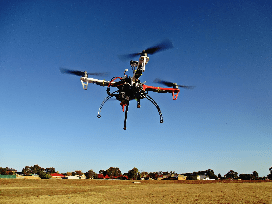Guest post by Alan Perlman, UAV Coach —

Here are five of the many applications for drones in society:
Search and Rescue
The most immediate societal application impacting humans might be the use of this technology in search and rescue operations.
The international group S.W.A.R.M. has more than 1,000 registered drone operators volunteering their time in search and rescue efforts.
Commissioning a helicopter for a search and rescue endeavor is a resource-intensive operation, and at some point, most government officials have to limit the resources dedicated to any single case/search.
While this is understandable, it is a hard pill to swallow for the parties involved. After government agencies have pulled out, organizations like SWARM move in to continue the search at the request of the individuals.
Government search agencies aren’t ignorant, either, as they too see the potential for adding drone elements to their search operations. The University of Nevada, Reno has gone as far as to put on the 1st Annual UAS Search and Rescue Symposium dedicated to agencies who are currently, or are looking to, add drone systems as part of their first response and emergency search operations.
Structural Inspections
This technology is perfect for structural inspections. Let’s take a bridge, for example:
Flying a helicopter close enough and keeping it steady can be dangerous to everyone involved. It’s also expensive and produces less desirable angles and missing details.
Sending someone on a tether to summit these monoliths would be hazardous to that person and time consuming. How about fixed cameras placed on the structure? They’re limited in application.
Drones are some of the best tools to handle these tasks. These UAV systems are agile, relatively small/lightweight, and are capable of capturing immensely high-quality images. This allows an inspection drone to get up close and personal with the structure without fear of human harm.
Bridges aren’t the only structures nicely fitted to this technology. For another example, look to flare stacks.
Flare stacks are tall ventilation pipes used in oil refineries to burn off flammable gas as part of the petroleum processing progression. These flare stacks are often several hundred feet tall and discharge flames with temperatures well over 2,000 degrees Fahrenheit, which make them a dangerous place for human inspection.
Refinery companies have, in the past, used helicopters to handle the process and traditionally gotten limited results. Now, they’re turning to drones to handle the task, as they’re able to get much closer to the structure.
Professional Image/Video Applications
Drones have become a game changer for aerial imaging and videography.
Previously, a company’s only options to get these types of views were to rent a jib or a helicopter/plane flyover for thousands of dollars. Even then, you were left up to the mercy of whichever operator came along with your rental choice.
With the ongoing innovation in sUAS, you can now take as many high quality variations of a shot as you need while incurring minimal costs.
Some of the most evident impacts on the commercial side can be seen in the real estate industry. Drones allow real estate agents to showcase properties as they are rarely seen. Even the FAA expects this trend to grow immensely in the years to come.
Mapping/Modeling for Construction Companies
Drones are also assisting construction companies with land surveying, mapping and modeling.
When a drone is combined with a mapping/modeling software package, construction workers and engineers can build detailed and accurate 3D models of the construction site.
This allows them to accurately plan a build before starting. Drones can even be used during the construction process to solve unanticipated issues that pop up.
Companies such as DroneDeploy and Pix4D offer software packages that turn an sUAS into a full-fledged 3D surveying machine. The feature has become so desired that drone manufacture, 3D Robotics, has partnered with Sony and Autodesk to build a new drone model with these features integrated into it.
Precision Agriculture
Of all of the applications discussed, one of the least obvious, but truly beneficial, societal applications can be seen in precision agriculture.
If you are a farmer and with a bird’s-eye view of your crops, you’re able to monitor the health of your crops and identify weeds with ease.
Farmers are using advanced remote controlled drone rigs to accomplish some astonishing tasks, such as aerial imaging, recreating and analyzing leaves on soybean plants from 400 feet up, or analyzing the nutrient uptake of a crop field to determine where to best apply fertilizer. The agricultural applications aren’t limited to crops, either, as farmers are also using drones for livestock herd monitoring.
These are just a few of the ways our society can apply drones in beneficial manners. What other applications have you heard of, seen, or engage in?
Let me know in the comments below.
Author Bio:
Frank Schroth is editor in chief of DroneLife, the authoritative source for news and analysis on the drone industry: it’s people, products, trends, and events.
Email Frank
TWITTER:@fschroth